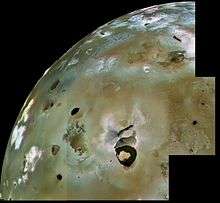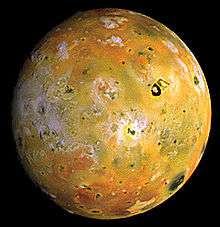Loki Patera

Loki Patera is the largest volcanic depression on Jupiter's moon Io, 202 kilometres (126 mi) in diameter.[1] It contains an active lava lake, with an episodically overturning crust.[2] The level of activity seen is similar to a superfast spreading mid-ocean ridge on Earth.[3] Temperature measurements of thermal emission at Loki Patera taken by Voyager 1's Infrared Interferometer Spectrometer and Radiometer (IRIS) instrument were consistent with sulfur volcanism.[4]
Io's lava lakes such as Loki Patera are depressions partially filled with molten lava covered by a thin solidified crust. These lava lakes are directly connected to a magma reservoir below.[5] Observations of thermal emission at several of Io's lava lakes reveal glowing molten rock along Loki Patera's margin, caused by the lake's crust breaking up along the edge of the patera. Over time, because the solidified lava is denser than the still-molten magma below, this crust can flounder, triggering an increase in thermal emission at the volcano.[6] At sites such as Loki Patera, this can occur episodically. During an overturning episode, Loki can emit up to ten times more heat than when its crust is stable.[2] During an eruption, a wave of foundering crust spreads out across the patera at the rate of about 1 kilometre (0.6 mi) per day, until the crust of the lake has been resurfaced. Another eruption would begin once the new crust has cooled and thickened enough for it to no longer be buoyant over the molten lava.[7]
Loki Patera is located at 13°00′N 308°48′W / 13°N 308.8°W[8]Coordinates: 13°00′N 308°48′W / 13°N 308.8°W[9]. It is named after the Norse god Loki.[10] Amaterasu Patera is located to the north and Manua Patera to the northwest.
See also
| Wikimedia Commons has media related to Loki Patera. |
References
- ↑ Radebaugh, J.; et al. (2001). "Paterae on Io: A new type of volcanic caldera?". J. Geophys. Res. 106: 33005–33020. Bibcode:2001JGR...10633005R. doi:10.1029/2000JE001406.
- 1 2 Howell, R. R.; R. M. C. Lopes (2007). "The nature of the volcanic activity at Loki: Insights from Galileo NIMS and PPR data". Icarus. 186 (2): 448–461. Bibcode:2007Icar..186..448H. doi:10.1016/j.icarus.2006.09.022.
- ↑ Rosaly M.C. Lopes and Tracy K.P. Gregg (2004). Lava Lakes on Jupiter’s Moon Io (abstract)
- ↑ Hanel, R.; et al. (1979). "Infrared Observations of the Jovian System from Voyager 1". Science. 204 (4396): 972–76. doi:10.1126/science.204.4396.972-a. PMID 17800431.
- ↑ Davies, A. (2007). "Effusive activity: landforms and thermal emission evolution". Volcanism on Io: A Comparison with Earth. Cambridge University Press. pp. 142–52. ISBN 0-521-85003-7.
- ↑ Matson, D. L.; et al. (2006). "Io: Loki Patera as a magma sea". J. Geophys. Res. 111: E09002. Bibcode:2006JGRE..11109002M. doi:10.1029/2006JE002703.
- ↑ Rathbun, J. A.; J. R. Spencer (2006). "Loki, Io: New ground-based observations and a model describing the change from periodic overturn". Geophysical Research Letters. 33 (17): L17201. arXiv:astro-ph/0605240
 . Bibcode:2006GeoRL..3317201R. doi:10.1029/2006GL026844.
. Bibcode:2006GeoRL..3317201R. doi:10.1029/2006GL026844. - ↑ "Loki Patera". Gazetteer of Planetary Nomenclature. USGS Astrogeology Research Program.
- ↑ "Loki Patera". Gazetteer of Planetary Nomenclature. USGS Astrogeology Research Program.
- ↑ "IO NOMENCLATURE". lnfm1.sai.msu.su. Retrieved October 19, 2007.
External links
- Loki Patera/NIMS at CICLOPS
- "NIMS Observes Increased Activity at Loki Patera, Io", JPL Planetary Photojournal
- "An Impact Genesis for Loki Patera?" Lunar and Planetary Science XXXVI (2005)
